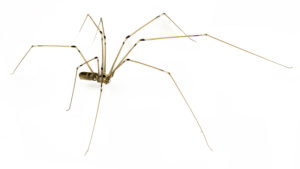 The common name of daddy-long-legs probably comes from their small body and very long, slender legs, and that of harvest-men because they are most often seen at harvest time. These are nuisance pests in and around structures. Adults have a a body about 1/16th to 1/2 inch long and males are usually smaller than females, but have longer legs.
The common name of daddy-long-legs probably comes from their small body and very long, slender legs, and that of harvest-men because they are most often seen at harvest time. These are nuisance pests in and around structures. Adults have a a body about 1/16th to 1/2 inch long and males are usually smaller than females, but have longer legs.
Females deposit their eggs in the ground, under stones, or in crevices of wood with a long ovipositor. In the north, eggs are laid in the autumn and hatch in the following spring. The young molt as soon as they reach the surface of the ground and molt several more times before becoming adults. In the north, adults die in the late autumn, but in the south, more hibernate and live for up to 2 years.
Adults usually are inactive during the day and remain in seclusion, but at sunset, they begin to wander about in search of food. They use their second pair of legs like antennae and carry their body up off the surface.
Daddy-long-legs feed on insects and spiders, with aphids being a favorite. Some species are scavengers, feeding on bird droppings and/or dead insects. They also eat vegetable juices such as from tender plants and fruits. Insects are caught with the leg like pedipalps, macerated with the chelicerae, and the liquids are consumed as well as some food particles.
Many species tend to migrate from where they hatched and congregate on structures or tree trunks. Around structures, they tend to be found outside under the eaves or in window sills. Inside, they can be found in garages or in damp crawlspaces and basements. Rarely are they found in the living areas of a structure.
Removal with a vacuum is recommended for both inside and outside. Outside, it may be desirable to treat congregation areas with an appropriately labeled pesticide. Wettable powders and microencapsulated products work best, but lacquer-based products are also quite effective.
